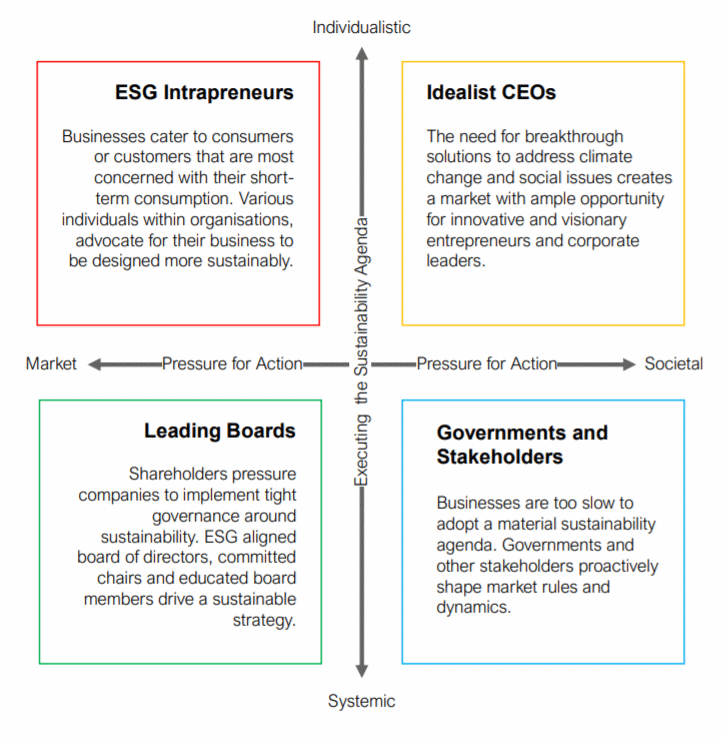
If you’ve ever been part of a bigger group discussing about how to scale out some (not only sustainability but also) initiative or other, you’ll have been quick to notice that by and large you’ll be faced with representatives of four distinct camps.
- The Grassroots advocates: those that believe that on the one hand consumers want to change their behaviour, and are just looking for ‘better’ options; while at the same time on the other hand assuming that operations I a company know best what to do – and actually get the job done.
- The advocates for ‘setting the tone at the top’: they assume that just by getting senior management, and the CEO in particular, to be visionary, leading the charge, would pave the way for everyone (and everything) else.
- Those in support of government regulation driven by civil society: Often originating from the NGO and campaign scene themselves, their underlying assumption is one of regulation and public pressure working hand-in-hand like two synchronized cogwheels.
- The ‘Fiduciary Duty Advocates’:
Much more recently, and in particular with efforts such as Chapter Zero taking root across the corporate world, the role of the boards have been recognised, and are now increasingly seen as the ultimate corporate unit leading the charge. This is notably due because the board indeed does sit at the interface between policy makers (aka government), senior executives of the company, and stakeholders (aka predominantly shareholders, but increasingly understood more broadly).
The truth obviously lies somewhere in the middle, and will hugely vary from company to company, from context to context, and from jurisdiction to jurisdiction.
The truth is also that all of these angles matter, and interact with each other. But any one of them really being the pivotal factor? Unlikely.
In fact, cynically speaking, the four angles do take turns in being in the limelight in what feels like a performance of musical chairs on continuous repeat.

Source: The Sustainability Board Report, ‘Sustainable Business Leadership in 2030: Four Scenarios’, p. 5, 06/2021 [Download].
The reality is …
All of those are required to make progress. And all at the same time.
Rather than talking about leadership, it would need to be a conversation about ‘hindering trends’ among them. Which of these trends, or hurdles, is most impactfully hindering the way forward?
‘Hindering’ again could take a number of different incarnations: lack of speed for example could be one (maybe applicable to policy development and regulation?); conservative and GDP growth focused attitudes another one (possibly applicable to stakeholder of all types, either being vocally for or indeed vocally against such measures of success); power dynamics in C-suites might be another hurdle to be addressed, often originating in a lack of ability, skill and knowledge (applies to the CEO and his team); and lastly: consumers’ price sensitivity and convenience is yet another hurdle that may hinder scale and impact.
‘Trends’? Nope. Scenarios? Possibly. Actors? Definitely!
So, are we truly talking about leadership ‘trends’, or indeed just leadership reality as any other topic would encounter also. Digitalisation and AI for example does see some of the same dimensions being of relevance. So does the conversation around sufficient as well as fair labour. Or indeed even the rather publicly conducted discourse on migration.
Maybe the conclusion is:
Consumers, C-Suite, the regulator and stakeholders are all important and powerful in their own way. All of these players are responsible. And influential. And relevant.
All of them must pitch in to make a difference. Without exception, nor excuses.
Further reading:
A short and insightful summary of the above four angles on sustainability leadership – called ‘trends’ in the document – is available in:
The Sustainability Board Report, ‘Sustainable Business Leadership in 2030: Four Scenarios’, p. 5, 06/2021.

